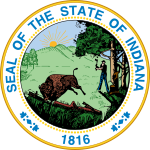
Back Historia de Indiana Spanish Histoire de l'Indiana French インディアナ州の歴史 Japanese История Индианы Russian
| History of Indiana | |
|---|---|
 The seal of Indiana reflects the state's pioneer era | |
| Historical Periods | |
| Pre-history | until 1670 |
| French Rule | 1679–1763 |
| British Rule | 1763–1783 |
| U.S. Territorial Period | 1783–1816 |
| Indiana Statehood | 1816–present |
| Major Events | |
| Tecumseh's War War of 1812 | 1811–1814 |
| Constitutional convention | June 1816 |
| Polly v. Lasselle | 1820 |
| Capitol moved to Indianapolis | 1825 |
| Passage of the Mammoth Internal Improvement Act | 1831 |
| State Bankruptcy | 1841 |
| 2nd Constitution | 1851 |
| Civil War | 1860–1865 |
| Gas Boom | 1887–1905 |
| Harrison elected president | 1888 |
| KKK scandal | 1925 |
The history of human activity in Indiana, a U.S. state in the Midwest, stems back to the migratory tribes of Native Americans who inhabited Indiana as early as 8000 BC. Tribes succeeded one another in dominance for several thousand years and reached their peak of development during the period of Mississippian culture. The region entered recorded history in the 1670s, when the first Europeans came to Indiana and claimed the territory for the Kingdom of France. After France ruled for a century (with little settlement in this area), it was defeated by Great Britain in the French and Indian War (Seven Years' War) and ceded its territory east of the Mississippi River. Britain held the land for more than twenty years, until after its defeat in the American Revolutionary War, then ceded the entire trans-Allegheny region, including what is now Indiana, to the newly formed United States.
The U.S. government divided the trans-Allegheny region into several new territories. The largest of these was the Northwest Territory, which the U.S. Congress subsequently subdivided into several smaller territories. In 1800, Indiana Territory became the first of these new territories established. As Indiana Territory grew in population and development, it was divided in 1805 and again in 1809 until, reduced to its current size and boundaries, it retained the name Indiana and was admitted to the Union December 11, 1816 as the nineteenth state.
The newly established state government set out on an ambitious plan to transform Indiana from a segment of the frontier into a developed, well-populated, and thriving state. State founders initiated an internal improvement program that led to the construction of roads, canals, railroads, and state-funded public schools. Despite the noble aims of the project, profligate spending ruined the state's credit. By 1841, the state was near bankruptcy and was forced to liquidate most of its public works. Acting under its new Constitution of 1851, the state government enacted major financial reforms, required that most public offices be filled by election rather than appointment, and greatly weakened the power of the governor. The ambitious development program of Indiana's founders was realized when Indiana became the fourth-largest state in terms of population, as measured by the 1860 census.
Indiana became politically influential and played an important role in the Union during the American Civil War. Indiana was the first western state to mobilize for the war, and its soldiers participated in almost every engagement during the war. Following the Civil War, Indiana remained politically important as it became a critical swing state in U.S. presidential elections. It helped decide control of the presidency for three decades.
During the Indiana Gas Boom of the late 19th century, industry began to develop rapidly in the state. The state's Golden Age of Literature began in the same time period, increasing its cultural influence. By the early 20th century, Indiana developed into a strong manufacturing state and attracted numerous immigrants and internal migrants to its industries. It experienced setbacks during the Great Depression of the 1930s. Construction of the Indianapolis Motor Speedway, expansion of the auto industry, urban development, and two wars contributed to the state's industrial growth. During the second half of the 20th century, Indiana became a leader in the pharmaceutical industry due to the innovations of companies such as Indiana based Eli Lilly.